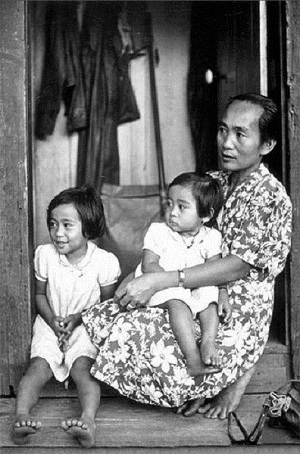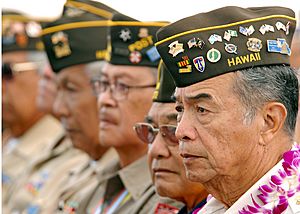Filipinos in Hawaii facts for kids
Quick facts for kids Total population |
|
|---|---|
| 342,095 (22.8%) | |
| Languages | |
| English, Hawaiian, Hawaiian Pidgin, Tagalog, Ilocano, Visayan, other Philippine languages | |
| Religion | |
| Catholicism, Protestantism, Buddhism, Muslims, Irreligion, Others | |
| Related ethnic groups | |
| Other Filipino Americans and Overseas Filipinos |
People of Filipino heritage form a big and growing part of Hawaii's population. In 2000, they were the third largest ethnic group. They made up 22.8% of all people living there. By 2010, they became the second largest group in Hawaii. They represented 25.1% of the population, just after White people.
The 2000 Census showed over 275,000 Filipinos in Hawaii. More than 191,000 of them lived on the island of Oahu. About 102,000 of these were immigrants. Filipinos were also the third largest Asian Pacific American group. They were the majority in Kauai and Maui counties. In 2002, the Filipino Community Center opened in Waipahu. By the 2010 census, Filipino Americans became the largest Asian group in Hawaii. This was partly because the number of Japanese Americans in the state had decreased. In 2011, a large number of Filipino immigrants in the U.S. lived in the Honolulu area.
Contents
History of Filipinos in Hawaii
Some studies suggest that the Philippine Islands might have been a home or a stop for ancient people. These were the Lapita people, who spoke Austronesian languages. They were ancestors of the Polynesians. This idea comes from DNA findings that link Polynesian chickens to the Philippines.
Early Filipino Settlers
A few Filipinos, known as "Manila men," came to the Kingdom of Hawaii in the 1800s. They often worked as cooks or musicians in the Royal Hawaiian Band. There was no organized movement of people during this time.
One important "Manila man" was Jose Sabas Libornio. He was born in Manila in 1858. Libornio was a Filipino composer. He led the Royal Hawaiian Band when the Hawaiian Kingdom was overthrown in 1893. He was a close friend of Queen Liliʻuokalani. She was the last ruler of Hawaiʻi. He may have helped write the Hawaiian protest song “Kaulana Nā Pua.”
After the overthrow, Libornio left Hawaii for Peru. In Peru, he became the Director General of Military Music Bands. He also wrote Peru's second national anthem, "March de Banderas."
Who Were the Manila Men?
The Manila men were some of the first Filipino overseas workers. They were the first Filipinos recorded to have come to North America.
Filipino Workers in the 1900s
The arrival of Filipino workers, called “Sakadas,” started in 1906 and lasted until 1946. "Sakadas" means "Filipino migrant workers." During this time, about 125,000 Filipinos were hired. They came from the Ilocos and Visayas regions of the Philippines. They came to work in Hawaii.
At first, the Hawaiian Sugar Planters' Association (HSPA) hired Filipino men. They worked in the sugarcane fields. Later, Sakadas also worked in pineapple fields. Filipino workers were brought in to replace Japanese workers. The Japanese workers had been striking for better pay and living conditions. The different ethnic groups were kept separate. This was to prevent Filipinos from joining the strikes. It also gave plantation owners more control.
Recruiters preferred Filipinos who had little education and experience in farming. They thought these workers would be easier to manage. Sakadas usually signed 3-year contracts. They did not plan to stay in Hawaii forever. Most wanted to earn money and return home to buy land. This was common until the 1940s. Their contracts included travel to Hawaii and back to the Philippines. By the 1940s, working in Hawaii was seen as a great opportunity. More Filipinos then chose to stay.
Workers lived in plantation barracks and paid rent. They worked long 10-hour days, six days a week. They were paid 90 cents a day. They earned the lowest wages among all ethnic groups on the plantations. Most Sakadas were single men. However, over time, some sent for relatives or brought their families.
The last group of Sakadas arrived in 1946. They were different from earlier groups. This group included more women, children, and relatives of previous Sakadas. Some also had an American education. Professionals were also part of this group.
The Hawaiian Sugar Planters' Association
The Hawaiian Sugar Planters’ Association (HSPA) brought many Filipino farm workers to Hawaii in 1906. They worked on the sugar plantations. Albert F. Judd, an HSPA recruiter, tried to bring three hundred Filipinos to Hawaii. These Filipinos went to the Olaa Plantation on the Big Island. The sugar industry was growing fast then. Hawaii and the Philippines had recently become part of the United States. They were used to support this industry.
By the 1920s, about 7,600 Filipinos arrived in Hawaii each year. Most Filipinos thought they would only live in Hawaii for a short time. This changed around the 1940s. The HSPA preferred Filipinos for sugar plantations. They were known to be hard workers. They also accepted the lowest wages of all ethnic groups on the plantations.
Challenges Faced by Filipino Workers
From 1906 to the 1940s, many Filipino workers (Sakadas) moved to Hawaii. They hoped for better work. As more Sakadas arrived, they started to see themselves as Filipino-Americans. However, some non-Filipino groups treated them poorly. They used unfair stereotypes about their culture. This meant that how Filipino-Americans were seen was often shaped by others. These ideas spread throughout Hawaii.
Most Filipino workers were men. When they arrived, stereotypes appeared. Some called them "poke-knives." They also used Filipino kinship terms in a mean way. Some stereotypes said Filipino men were very emotional, violent, or likely to commit crimes. For example, a 1926 book called Temperament and Race compared traits in different groups, including Filipinos. This study made Filipino men workers in Hawaii seem worse. Because of these stereotypes, Filipino men were more often charged with minor crimes and serious offenses. They were also the most likely group in Hawaii to receive the most severe punishments in the first half of the 1900s.
Hawaii's media, like the Honolulu Daily newspaper and radio, often focused on Filipinos. They highlighted their convictions on front pages. This made Filipinos seem like the main cause of violence. Historically, Filipinos during the Plantation era had less power in society. So, Filipino-Americans found it hard to fight these stereotypes. Many of these unfair ideas still exist today.
Impact on Hawaii's Working Class
Some Native Hawaiians worked with Filipinos on the sugar plantations. The sugar industry was the main way people earned money in Hawaii. So, there was a high demand for these jobs. American sugar plantation owners could not get enough Native Hawaiians to work for them. So, they relied heavily on bringing in workers from other places.
Filipinos in the Late 1900s
The United States Immigration and Nationality Act of 1965 made it easier for Filipinos to bring their families to Hawaii. This led to more Filipinos arriving, especially women. This increase also caused some problems. In the 1970s, Filipinos felt they were treated unfairly. They also tended to do less well in schools during that decade. The reasons for this are not fully known, but unfair treatment may have played a part. In 1970, only 34.4% of the 93,915 Filipinos in Hawaii had finished high school.
Former President Ferdinand Marcos spent his last years in Hawaii. His long period of rule in the Philippines ended in 1986. This happened because of the People Power Revolution. When he left the Philippines for Hawaii, he brought a lot of wealth with him. This included cash, jewelry, precious gems, watches, pearls, a gold statue, and gold bars. He also had bank slips for millions of dollars. He had gathered all this wealth during his time in power. While in Hawaii, he and his family lived a very luxurious life. They lived in a fancy house and shopped in expensive areas. His wife, Imelda, hosted many costly parties. Meanwhile, Filipinos in the Philippines suffered from the large debt the Marcos family had caused. Experts believed this debt might be fully paid off by 2025.
Filipino Population and Life in Hawaii
The 2010 census showed that Filipinos became the largest racial group in Hawaii, surpassing Japanese. The total Filipino population was 342,095. Of these, 197,497 were full Filipinos. The total Japanese population was 312,292, with 185,502 being full Japanese. Surveys from the American Community Survey showed Filipinos overtook Japanese between 2007 and 2008.
Dean Itsuji Saranillio, a Filipino-American scholar from Hawaii, has talked about how some Filipinos might forget the history of Native Hawaiians. He wrote that Filipinos in Hawaii often seek power as "Americans." But he also said they should remember the history of the U.S. in Hawaii. He believes they should support the rights of Native Hawaiians.
In 2020, there were 383,200 Filipino Americans in Hawaii. About a quarter of Hawaii's population are Filipino Americans. In 2019, they were the second largest ethnic group in Hawaii, after European Americans. Filipino Americans in Hawaii have a slightly higher average family income. However, their individual income ($27,738) is lower than the overall population's ($36,989). Also, Filipino Americans in Hawaii are less likely to earn a Bachelor's Degree.
It seems that groups like Filipinos, Samoans, and Hawaiians have faced challenges in moving up economically. Filipino Americans and other immigrant groups have had fewer chances. This has kept them in lower-paying service jobs and other manual labor jobs. These jobs make it harder for them to improve their economic situation. Most Filipino Americans in Hawaii live in homes with multiple generations. Nearly one-third of them work in the service industry. During the first year of the COVID-19 pandemic, about one-fifth of all COVID-19 cases in Hawaii were among Filipino Americans. The 2023 Hawaii wildfires on Maui greatly affected the Filipino American community in Lahaina. Before the fires, 40% of Lahaina's population was Filipino American.
See also



